|
|
|
The Land and Its People
|
The Seasonal Cycle
The rice planting season usually
begins in April or May. Rice is by far
the most important of all Thai crops and
the principal food for people throughout the country. Whether boiled or
steamed, distilled into a liquor known
as lao khao or transformed into sweets
and noodles, rice and its cultivation
forms a central pillar of Thai life. Kin khao, the Thai expression for "to eat,"
literally means "to eat rice." The grain
provides major government revenues
and for centuries has heen Thailand's
leading agricultural export.
Visakha Puja. the year's greatest
religious holiday, which commemorates
the Buddha's birth, enlightenment, and
death, comes during seeding and
ploughing. Village elders attend temple
celebrations and sermons during the day,
while those who have been working in
the fields return at dusk to join the
solemn candle or torchlit procession that
circumambulates the monastery chapel
three times. Each person carries
flowers, three glowing incense sticks.
and a lighted candle in silent homage
to the Buddha, his teaching, and his disciples.
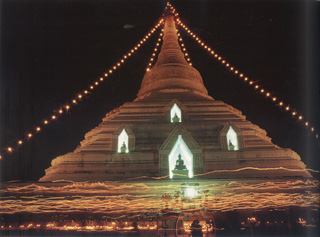
Visakha Puja, the year's greatest religious holiday |
Shortly after transplanting is
completed, usually towards the end of
May, the first of the annual monsoon
rains arrive to innundate farmland. Daily
rainfall replenishes the fields and while
the rice is growing much of the family's time is taken up with Rains Retreat
observances.
During this annual three-month
period (Phansa in Thai), Buddhist
monks are required to remain in their
monasteries overnight, a tradition which
predates Buddhism. In ancient India, all
holy men, mendicants, and sages spent
three months of the rainy season in
permanent dwellings, thus avoiding
unnecessary travel during the time crops
were still new for fear they might
accidentally tread on young plants,
In deference to popular opinion, the
Buddha decreed that his followers also
abide hy this tradition. This initiated a
move away from an itinerant life to a
more or less settled existence since the
advantages of a communal life style
became apparent.
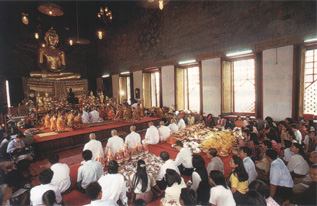
Pransa represents a time of renewed spiritual vigour. Monks meditate more, study more, and teach more. |
Phansa represents a time of renewed
spiritual vigour. The monk meditates
more, studies more, and teaches more.
Laymen, too, endeavour to be more
conscientious, perhaps abstaining from
liquor and cigarettes and giving extra
financial and physical support to local
monasteries. As already noted, this is
also the period when young men enter
the monastery for spiritual training.
The Buddhist ordination is a
mixture of religious solemnity, meritmaking, and boisterous celebration,
reflecting the Thai belief that the three
most important events in a man's life
are his birth, his ordination, and his
marriage. The ordination ritual itself
originated more than 2,500 years ago as
the Sangha (the Buddhist monastic
order) took shape and has changed little
to this day. Socially, it is something in
which the entire village participates.
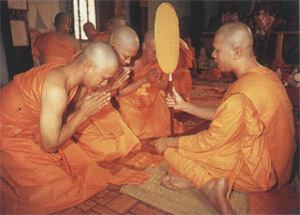
Pransa represents a time of renewed spiritual vigour. Monks meditate more, study more, and teach more.
|
Local monks comprise the presiding
chapter and preceptors, while villagers
gain merit by accompanying the
tonsured, white-robed candidate for
monkhood (known as the nak) in a
colourful procession to the monastery,
often marked by joyous dancing and
the infectious pounding of long drums.
Symbolism pervades every aspect
of the ordination ceremony. The nak's
white robe connotes purity and the royal
umbrella held over his head reminds
participants of the royal heritage Prince
Siddharta Gautama renounced during
his spiritual quest to become thc Buddha.
The nak leads the villagers in a triple
circumambulation of the monastery
chapel to evoke the Buddhist Triple
Gem the Buddha, the Dhamma. and
the Sangha (the Teacher, the Teaching,
and the Taught).
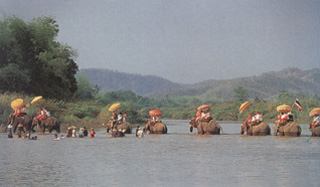
The entire village participates in an ordination ceremony.
|
Once the rains end. the daily
rhythm of fieldwork is increasingly
concerned with keeping birds away from
the ripening rice. During this time fish
are abundant in rain-swollen streams
and fields. Methods and equipment for
freshwater fishing vary from region to
region and depending on where the
fish are being caught canals, rivers,
ponds, or rice fields.
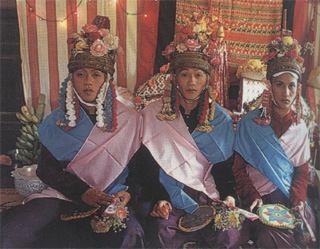
The entire village participates in an ordination ceremony. |
In early November, one of the most
beautiful of Thai festivals, Loy Krathong,
takes place. Loy means "to float" and a
krathong is a lotus-shaped vessel made
of banana leaves. The krathong usually
contains a candle, three incense slicks.
some flowers, and a few coins. By the
light of the full moon, people light the
candles and incense, make a wish. and
launch their krathongs on the nearest
body of water. The spirit of the water,
who plays such an important part in
rural life, is thus honoured, and it is also
commonly believed the krathongs carry
away the past year's troubles and bear
the launchers' hopes tor the future.
Moonlit waterways throughout Thailand
are covered with tiny, flickering lights.
representing millions of silent aspirations.
By late November or early December rice in the north and the central
plains is ready to be harvested. Wherever
possible, water is drained to allow the
fields to dry. Harvesting schedules are
determined by common consent within
each village. Early each morning cooperative work groups go into the fields
with sickles to harvest each farmer's
crop. Around noon, the host family
sends food to the workers, and after
lunch work resumes until dark, when the
host family provides another meal.
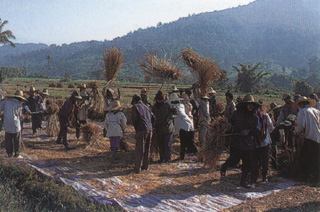
Harvesting duties are carried out by common consent
|
The cut rice is spread on the fields
to dry for several days before being
bundled into sheaves and taken to dhe
family compound, where it is threshed
and winnowed. Except in the south.
where later monsoons arrive late in the
year. harvesting usually ends in January
or February. Then the farm family turns
its enemies to activities neglected during
the harvest. Buildings, tools, and fences
are repaired and secondary crops are
either planted or harvested.
The hot dry season that follows is
marked by the Songkran festival, which
celebrates the traditional Thai New Year.
At this time people from rural areas who
are working in the city usually return
home for the festivities. Songkran is
observed nationwide, but with special
elan in the north where, because it occurs during a
time of relative leisure, it becomes a three to five day
festival of entertaining and socialising.
A thorough house cleaning, sprinkling of
Buddha images with lustral water, memorial
ceremonies, merit-making presentations
of gifts to monks, elders, and spirits, the
release of caged birds and fish, pilgrimages
to holy shrines, parades, dancing, and
uninhibited, good-natured water throwing
are all features of the Songkran celebration.
Around this time, showers signal
the approaching end of the dry season,
and villagers once more prepare for rice
planting as one annual cycle ends and another begins.
| | |
|
|